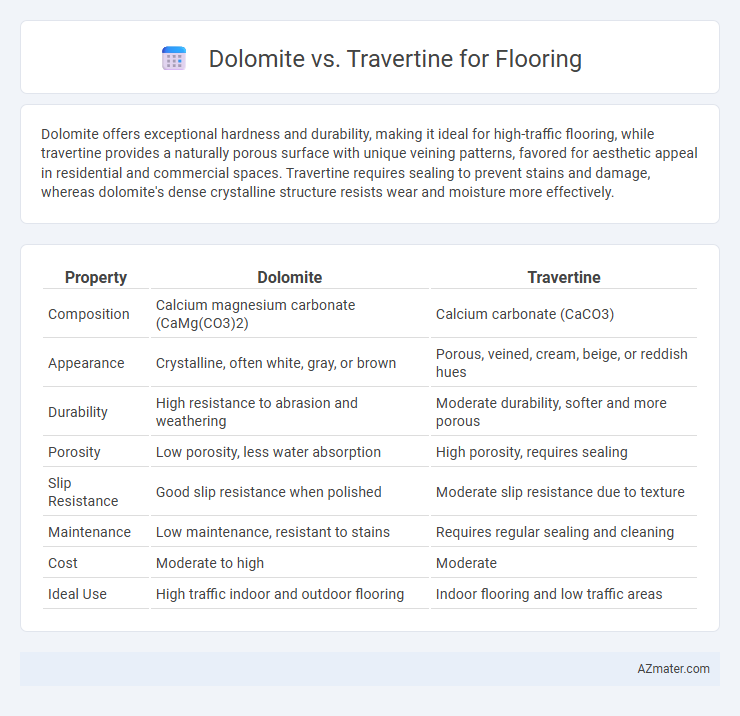Dolomite offers exceptional hardness and durability, making it ideal for high-traffic flooring, while travertine provides a naturally porous surface with unique veining patterns, favored for aesthetic appeal in residential and commercial spaces. Travertine requires sealing to prevent stains and damage, whereas dolomite's dense crystalline structure resists wear and moisture more effectively.
Table of Comparison
| Property | Dolomite | Travertine |
|---|---|---|
| Composition | Calcium magnesium carbonate (CaMg(CO3)2) | Calcium carbonate (CaCO3) |
| Appearance | Crystalline, often white, gray, or brown | Porous, veined, cream, beige, or reddish hues |
| Durability | High resistance to abrasion and weathering | Moderate durability, softer and more porous |
| Porosity | Low porosity, less water absorption | High porosity, requires sealing |
| Slip Resistance | Good slip resistance when polished | Moderate slip resistance due to texture |
| Maintenance | Low maintenance, resistant to stains | Requires regular sealing and cleaning |
| Cost | Moderate to high | Moderate |
| Ideal Use | High traffic indoor and outdoor flooring | Indoor flooring and low traffic areas |
Introduction to Dolomite and Travertine Flooring
Dolomite flooring, derived from a sedimentary carbonate rock rich in magnesium and calcium, offers a durable and visually appealing surface with natural variations in color and texture. Travertine flooring, formed from mineral deposits in hot springs, is prized for its porous texture and warm earthy tones, providing a classic and elegant aesthetic. Both materials are valued in flooring for their unique patterns and resilience, making them popular choices in residential and commercial spaces.
Key Characteristics of Dolomite
Dolomite flooring offers exceptional hardness and durability, making it highly resistant to scratches and wear compared to travertine, which is softer and more porous. Its dense crystalline structure provides a natural resistance to moisture and stains, enhancing longevity in high-traffic areas. Dolomite also boasts a unique shimmer and subtle color variations, delivering a luxurious and timeless aesthetic for residential and commercial spaces.
Key Characteristics of Travertine
Travertine flooring features a porous, natural stone surface with unique, earthy tones ranging from beige to rust, offering a timeless, rustic aesthetic. Its durability and slip-resistant texture make it ideal for both indoor and outdoor applications, especially in warm climates. The stone's ability to age gracefully and develop a patina over time enhances its appeal in high-traffic areas.
Appearance and Design Options
Dolomite flooring offers a smooth, crystalline texture with subtle color variations, creating a sleek and modern aesthetic ideal for minimalistic interiors. Travertine showcases a natural, porous surface featuring distinctive pits and veins that contribute to a rustic, timeless appeal suitable for Mediterranean or traditional designs. Both materials provide diverse color palettes, but travertine's patterns and textures offer more dynamic visual interest compared to dolomite's consistent, polished finish.
Durability and Strength Comparison
Dolomite offers superior hardness and scratch resistance compared to travertine, making it more durable for high-traffic flooring areas. Travertine, while visually appealing with its unique porous texture, is softer and more prone to chipping and wear over time. The dense crystalline structure of dolomite ensures greater strength and longevity, ideal for both residential and commercial flooring applications.
Maintenance Requirements
Dolomite flooring requires minimal maintenance due to its dense structure, resisting stains and scratches effectively. Travertine, characterized by its porous surface, demands regular sealing to prevent moisture penetration and staining, increasing upkeep efforts. Both stones benefit from gentle cleansers and prompt spill management, but Dolomite's durability offers a lower-maintenance advantage in high-traffic areas.
Cost Differences
Dolomite flooring generally comes at a higher price point than travertine due to its greater density and durability, making it ideal for high-traffic areas. Travertine offers a more budget-friendly option with costs typically ranging from $4 to $7 per square foot, while dolomite can cost between $6 and $12 per square foot. Choosing between these materials depends on balancing initial investment against long-term wear and maintenance expenses.
Slip Resistance and Safety
Dolomite offers a textured surface with higher slip resistance, making it safer for high-traffic or wet areas compared to the smoother, more polished surface of travertine. Travertine's porous nature requires sealing to enhance its grip and prevent slips, especially in bathrooms or outdoor spaces. For optimal safety, dolomite typically outperforms travertine due to its natural roughness and durability, reducing the risk of accidents on flooring.
Best Applications for Each Stone
Dolomite flooring excels in high-traffic areas like commercial spaces and kitchens due to its exceptional durability and resistance to wear. Travertine offers a more elegant look suitable for indoor living areas, bathrooms, and light-traffic hallways, where its porous texture adds natural beauty and slip resistance. Both stones require proper sealing, but travertine's softer composition makes it less ideal for outdoor use compared to the harder, more weather-resistant dolomite.
Conclusion: Choosing the Right Stone for Your Floor
Dolomite offers superior hardness and durability, making it ideal for high-traffic areas, while travertine provides a more natural, porous texture that enhances aesthetic appeal with unique veining patterns. Consider maintenance requirements: dolomite requires less frequent sealing compared to travertine, which is more prone to staining and erosion. Assess your flooring needs based on durability, appearance, and upkeep to select the best stone for your space.

Infographic: Dolomite vs Travertine for Flooring
 azmater.com
azmater.com